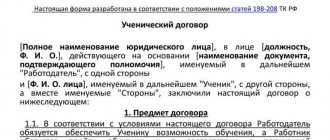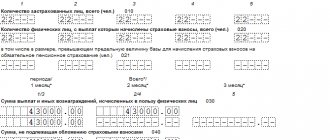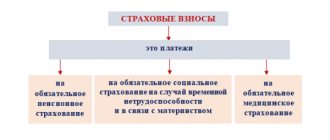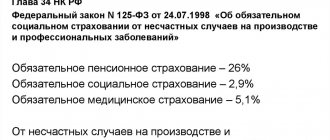Types of insurance
Let us immediately make a reservation that tax rules, especially in terms of income tax, strongly depend on the type of insurance that the employer decided to include in the “social package”.
So, there may be insurance in case of disability or death. In addition, the legislation provides for the possibility of insurance in case of temporary disability. However, these insurance options are rather exotic, which most accountants do not have to deal with. Most often, the social package includes voluntary health insurance policies, which give employees the opportunity to receive medical care in medical institutions accredited by the insurance company (clinics, hospitals, emergency rooms, sanatoriums, etc.). We will focus on this type of insurance.
What is VHI for a company?
VHI is one of the types of medical insurance, but it covers a much larger list of medical services than a regular medical policy, which is issued to every citizen of the Russian Federation under the compulsory medical insurance system (Article 927 of the Civil Code of the Russian Federation and Article 4 of the Law of the Russian Federation No. 4015-1 “On Organization insurance business in the Russian Federation" dated November 27, 1992).
In order for a company to include in its benefits the availability of a voluntary health insurance program for its employees, the organization enters into an agreement with an insurance company (one or more) for one or more health insurance programs.
According to the terms of insurance on the territory of the Russian Federation, the employing company is recognized as the policyholder, and the insurance company is recognized as the insurer. The agreement is concluded in the manner and according to the requirements specified in Chapter. 48 Civil Code of the Russian Federation.
Concluding an agreement with an insurance company implies that the employing organization will have an expense item related to employee wage costs. In this connection, questions may arise about the accounting of expenses and the taxation of profits (accounting for these expenses in expense items that affect the formation of taxable profit).
Three conditions for VHI
So, the company's management decided to provide employees with health insurance. To do this, the company will need to conclude a voluntary personal insurance agreement with an insurance organization in favor of third parties (employees).
Accordingly, the employer’s responsibilities include paying for such insurance, and employees will directly use the services of medical institutions. The Tax Code allows you to take into account the cost of such insurance. True, there are several “buts”.
So, firstly, the obligation to provide employees with insurance must be stated in the labor or collective agreement (Clause 1 of Article 255 of the Tax Code of the Russian Federation). Secondly, expenses can only include those amounts that are transferred to pay for employee insurance, i.e. persons with whom the organization has an employment contract. Third, the amount that can be expensed is limited to six percent of total labor costs. Finally, fourthly, the insurance contract itself must be concluded for a period of at least a year. Let's consider these conditions in detail.
Calculation examples
XXX LLC entered into a voluntary health insurance agreement from 03/01/2017 to 02/28/2018. The insurance premium is 450 thousand rubles, payable at a time. Labor costs amounted to:
- March 2021: RUB 615,248.37;
- April 2021: RUB 594,326.20;
- May 2021: RUB 602,145.85;
- June 2021: RUB 762,304.58;
- July 2021: RUB 612,419.54;
- August 2021: RUB 606,230.87;
- September 2021: RUB 795,364.02;
- October 2021: RUB 592,361.20;
- November 2021: RUB 601,005.43;
- December 2021: RUB 986,348.17;
- January 2021: RUB 550,316.94;
- February 2021: RUB 560,497.12
Calculation of insurance premiums for each month:
The maximum amount of costs for voluntary health insurance in March 2021 will be:
615,248.37 * 6% = 36,914.90 rub.
Insurance premiums exceed the permissible limit, therefore, the entire amount will be written off in accounting records, and only RUB 36,914.90 in tax records.
The difference is 38,219.18 – 36,914.90 = 1,304.28 rubles. will be attributed to permanent differences.
The permanent tax liability will be: 1,304.28 * 20% = 250.86 rubles.
In April 2021, the cumulative total of contributions will be equal to:
38,219.18 + 36,986.30 = 75,205.48 rub.
The maximum amount of expenses will be:
(615,248.37 + 594,326.20) * 6% = RUB 72,574.47
Since the limit has been exceeded, insurance costs will be written off as follows:
- within acceptable costs: 72,574.47 – 36,914.90 = 35,659.57 rubles;
- above the norm: 36,986.30 – 35,659.57 = 1,326.72 rubles;
- permanent tax liability: 1,326.72 * 20% = 265.35 rubles.
For subsequent months, calculations are made in a similar way.
To determine the allowable amount of costs for voluntary health insurance, the amount of labor costs is taken on an accrual basis from the start date of the contract until the end of the calendar year.
With the new year, the summation begins anew.
What do we write in the contract?
Let's start with the employment contract. It is clear that this condition must be enshrined in employment contracts with employees, but this can be done in different ways.
So, this may be a direct indication in the contract that the employer is obliged to insure the employee under the VHI program. Or there may be a link to a local regulatory act - Regulations on Social Guarantees, Internal Labor Regulations, etc., which contains a similar condition. Moreover, if the first option is chosen, then all the “particulars” (such as: from what moment insurance is provided, whether it is valid upon dismissal, transfer, transfer to another position, the scope of this insurance) must be recorded either also in the contract, or by reference to the corresponding local act.
You also need to clearly ensure that the list of insured persons coincides with the list of employees of the organization. After all, the expenses taken into account when taxing profits can only include those amounts that are paid under insurance contracts for persons who have a valid employment contract with the organization. Of course, paying for insurance for family members of employees or for persons with whom the organization has civil contracts is possible. But such expenses will not reduce the tax base for profits.
Changing the list of insured persons during the term of the contract
The described technique does not cause difficulties for the user until the list of insured persons specified in the contract begins to change.
During the year, some of the insured employees may quit, and newly hired employees may be included in the list of insured persons by concluding an additional agreement to the insurance contract. If the total number of insured persons does not change, the term of the contract remains the same (more than a year), and other essential terms of the contract do not change, then insurance premiums under such contracts are accepted as a reduction in the tax base for income tax (letter of the Ministry of Finance of Russia dated August 27. 2007 No. 03-03-06/4/118). The Tax Code establishes a limitation only for the general period for which the contract is concluded, and not for the period of insurance of a specific employee (Resolution of the Federal Antimonopoly Service of the Ural District dated December 15, 2009 No. F09-9912/09-S3).
If the number of insured persons increases due to newly hired employees, as indicated in the additional agreement to the VHI agreement, then the insurance premium can also be taken into account for taxation (clause 2 of Article 942 of the Civil Code of the Russian Federation, letter of the Ministry of Finance of Russia dated November 16, 2010 No. 03 -03-06/1/731).
But if an employee quits and the employer continues to pay for insurance for him without terminating the contract with the insurer, then the part of the insurance premium that falls on dismissed employees must be excluded from the expenses taken into account for tax purposes (letter of the Ministry of Finance of Russia dated May 5, 2014 No. 03- 03-06/1/20922).
Let’s change the conditions of Example 1 and see how insurance premiums for VHI can be taken into account, including those paid for dismissed employees.
Example 2
On the last day of February 2015, 5 insured persons specified in the VHI agreement quit their jobs, while Andromeda LLC continues to pay for health insurance for them. The annual cost of the insurance premium paid in respect of each employee is 12,000 rubles. Labor costs for calculating the standard specified in Example 1 do not change.
The number of calendar days in January and February 2015 is 59 (31 days + 28 days). Accordingly, the number of calendar days remaining under the voluntary health insurance contract attributable to dismissed employees is 306 (365 days - 59 days).
Let's calculate the share of the bonus attributable to dismissed employees, which is excluded from expenses:
(RUB 12,000 x 5 people) / 365 days x 306 days = RUB 50,301.37
Let's create an Operation document (section Operations -> Operations entered manually) and date it to the beginning of March. In the document form, to create a new transaction, you must click the Add button and enter correspondence for the debit of account 91.02 and the credit of account 76.01.9 for the amount excluded from further calculations for future expenses (Fig. 5). For tax accounting purposes for income tax, you need to enter the amounts into special resources of the accounting register:
Amount PR Dt 91.02 - for the constant difference in the cost estimate; The amount of NU Kt 76.01.9 is the amount of the insurance premium for dismissed employees.
Rice. 5. Exclusion of VHI expenses for dismissed employees
Starting from March 2015, when performing the regulatory operation Write-off of deferred expenses, the amount of the balance of the insurance premium adjusted downwards according to accounting and tax accounting data, which could potentially be recognized as expenses, will already be used. Further stages of calculating VHI expenses will not differ in any way from the stages described in Example 1. In December 2015, the lump sum of the insurance premium paid is completely debited from account 76.01.9. Taking into account the adjustments made, the amount of the insurance premium that could potentially be included in expenses is RUB 429,698.63. (480,000.00 rubles - 50,301.37 rubles), and the maximum amount of expenses for voluntary health insurance for 2015 is still determined as 436,080.00 rubles.
Obviously, the expenses include the amount of 429,698.63 rubles. as the minimum of two amounts. Figure 6 shows the Certificate of Cost Rationing for December 2015. The indirect expenses reflected in line 040 of Appendix No. 2 to Sheet 02 of the income tax return include the amount of expenses for voluntary health insurance equal to 429,698.63 rubles. In terms of VHI expenses at the end of the year, there are no differences between accounting and tax accounting data.
Rice. 6. Certificate-calculation of rationing costs for VHI for January 2015
In conclusion, we note that a one-time payment of an insurance premium is not always convenient. A more rational option is when the contract provides for payment of the insurance premium in installments, for example, quarterly. At the same time, the amount of the quarterly payment may be adjusted taking into account newly arrived and dismissed employees, an updated list of which is indicated in the additional agreements to the contract. Accounting for VHI expenses in the program will not change with this option: the payment amount will be written off during the quarter through the deferred expenses mechanism, and the standard in any case is calculated on an accrual basis for the year.
IS 1C:ITS
For more information on accounting for the costs of voluntary health insurance for employees, see the reference book “Accounting for corporate income tax” in the “Accounting and tax accounting” section.
Cost Allocation
Let's now look at when VHI costs are taken into account. To do this, let us turn to paragraph 6 of Article 272 of the Tax Code. It says that the procedure for recognizing expenses for paying for insurance under contracts concluded for a period of more than one reporting period (in the case of voluntary health insurance, expenses for shorter contracts simply do not fall into expenses, since according to the Tax Code of the Russian Federation the minimum period is one year) depends on how the company pays for the insurance company's services. The Tax Code offers two possible options - a one-time payment and several payments over insurance periods.
In the first case (one-time payment), the amount paid under the insurance contract is expensed evenly throughout the entire term of the contract, in proportion to the number of calendar days the contract is valid in the reporting period.
In the second case (several payments over insurance periods), each payment must be recognized evenly over a period corresponding to the period for which the payment was transferred, again in proportion to the number of calendar days of the contract in the current reporting period.
In practice, a third option is also possible, which is not described in the Tax Code. We are talking about cases of installment payment, when the contract does not clearly indicate for what period each specific payment is made. This is a regular installment plan, when the contract only sets the dates for making the next payment, but there is no link between this payment and the insurance period. The Tax Code does not say what to do in this case. If we apply here the logic used in Article 272 of the Tax Code of the Russian Federation, it turns out that each payment must be evenly distributed over the period from the date of payment transfer to the end date of the insurance period.
VHI in accounting
VHI insurance premiums are taken into account in accounting every month evenly throughout the entire term of the contract. When reflecting insurance premiums, the following entries are used:
D 76 (97) K 51 – insurance premiums paid
D 20 (23, 25, 26, 44) K 76 (97) – the costs of employee insurance for 1 month are taken into account
D 90 (91.2) K 20 (23, 25, 26, 44) – the insurance amount is included in the financial result
D 99 K 68 - a reflection of the permanent difference if contributions exceeded 6% of the wage fund (
Personal income tax and contributions to funds
The insurance premiums that the employer pays under the VHI agreement do not create taxable income for the insured employees due to the direct indication of this in paragraph 3 of Article 213 of the Tax Code of the Russian Federation. Please note that, unlike income tax, there is no regulation regarding personal income tax. Even if the employer was unable to fully include in expenses the amount paid under the insurance contract, personal income tax does not arise for employees insured under such a contract.
There is no obligation to accrue personal income tax regarding the cost of medical services that insured employees receive under the VHI program paid for by the employer. This is stated in subparagraph 3 of paragraph 1 of Article 213 of the Tax Code of the Russian Federation. The only exception is payment for health resort treatment through insurance. Here personal income tax arises, but the agent for this payment is not the employer, but the insurance company (clause 1 of Article 226 of the Tax Code of the Russian Federation). It is she who will have to calculate the personal income tax from the cost of the voucher, if possible, withhold it and transfer it to the budget, or inform the inspectors about the impossibility of withholding (clause 5 of Article 226 of the Tax Code of the Russian Federation, determination of the Supreme Arbitration Court of the Russian Federation dated November 10, 2010 No. VAS-14352/10). So the accountant of the employing organization has nothing to worry about.
The issue of contributions to extra-budgetary funds is resolved in a similar way. According to subparagraph 5 of paragraph 1 of Article 9 of Federal Law No. 212-FZ of July 24, 2009, payments under voluntary personal insurance contracts for employees that provide for payment for medical services and are concluded for a period of at least one year are exempt from the calculation of contributions. At the same time, the legislator, as in the case of personal income tax, did not establish any standards for this benefit. This means that there is no need to accrue contributions for payments in favor of employees, even if part of the expenses under the contract is not taken into account when taxing profits.
Voluntary health insurance agreement
The parties to the VHI agreement are the employer and the insurance company. The employer is obliged under the contract to pay insurance premiums, and the insurance company is to provide employees with medical services in the volumes stipulated by the contract. For this purpose, the insurance company, in turn, enters into contracts with medical organizations, which ultimately provide services to employees. When concluding a VHI agreement, it is important to pay attention to its validity period, as well as the moment when the agreement comes into effect.
Advanced features of “1C: Salaries and HR management 8 CORP” (rev. 3)
The tools for accounting for VHI contracts and policies discussed above are just an example of the expanded functionality of the 1C: Salaries and Personnel Management 8 CORP program, edition 3.
The program "1C: Salary and personnel management 8 CORP" (revision 3) fully contains all the possibilities of regulated personnel records, calculation and accounting of wages, calculation of personal income tax and contributions, preparation of reports, implemented in "1C: Salary and personnel management 8 "(ed. 3). In addition to this, “1C: Salaries and Personnel Management 8 CORP” edition 3 includes the following modules:
- labor protection;
- selection, assessment, training of personnel;
- setting up complex employee motivation schemes based on key performance ratio (KPI) and the value of benefits, both monetized and social, etc.
By choosing the program “1C: Salary and HR Management 8 CORP” edition 3 when moving from previous editions, the user receives not only a comprehensive solution for personnel accounting and payroll calculation, but also tools for integration with recruiting sites, the ability to conduct an electronic interview using Svetlana Ivanova’s method , conducting courses using an e-learning system, setting up a chatbot and much more.
Positive aspects of VHI for an employer
Every employer wants to have the status of a successful company not only in the eyes of clients and suppliers, but also in the eyes of its own employees. A good social package, including additional medical insurance, which allows you to receive free medical services that are not covered by a standard medical insurance policy, can help you achieve the desired result. This attitude allows organizations to increase the loyalty of their employees and raise their motivation to a higher level.
Additional health insurance is also useful for the employer in that when calculating income tax, the costs of its acquisition can be taken into account as reducing the tax base, which, as a consequence, reduces the amount of tax paid.
Procedure for voluntary health insurance for employees
In order to take advantage of tax benefits, legal entities should be attentive to the procedure for additional medical insurance for employees, since the company will be able to reflect the costs for them only if it concludes with the employee not only a properly executed employment contract, but also an insurance agreement.
However, along with this, the employer first of all faces the question of finding a reliable insurance company that provides comparative services. Often, company management trusts the advice of business partners and chooses the recommended insurance service. Then a letter is sent to it, in which the organization’s management proposes to discuss the possibility of concluding a deal and its terms. When both parties are satisfied with the conditions, an appropriate agreement is concluded, and a legal entity wishing to purchase insurance for its employees acquires the status of an insured.
Important ! The policyholder may wish to conclude an additional health insurance agreement not for all of its employees, but only for those who are of particular value or are engaged in heavy work. In this case, an appendix indicating the list of persons subject to insurance must be attached to the contract.
In addition, some organizations may insure not only their employees, but also their family members. This practice is quite rare, but it does happen.










